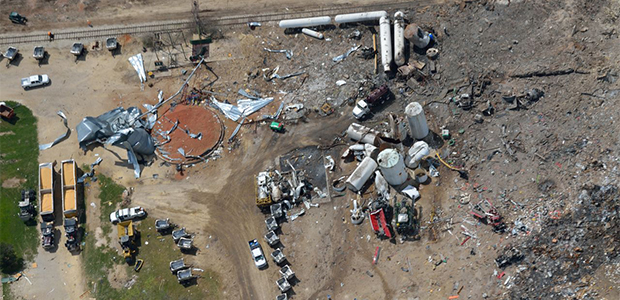
West Report Calls for OSHA, EPA Regulatory Changes
The board's report calls on OSHA and EPA to strengthen their regulations to protect the public from hazards posed by fertilizer grade ammonium nitrate. "Overall," said CSB Lead Investigator Johnnie Banks, "the CSB's investigation found that training and reference materials did not adequately inform emergency responders about the potential for FGAN to detonate in a fire."
The U.S. Chemical Safety Board released its comprehensive final report on the April 17, 2013, West Fertilizer fire and explosion in West, Texas, including the safety recommendations, at a Jan. 28 public meeting in Waco. The blast killed 15 people, most of whom were volunteer firefighters, and caused more than 260 injuries and widespread community damage. About thirty tons of fertilizer grade ammonium nitrate (the report refers to this as FGAN throughout) exploded after being heated by a fire at the storage and distribution facility.
The report contains several recommendations for OSHA, EPA, and other organizations, including the International Code Council, the U.S. Department of Homeland Security, the Texas Commission on Fire Protection (which the board recommended should develop a training program specific to FGAN), and others.
For EPA:
- Develop a guidance document on Emergency Planning and Community Right-to-Know Act requirements that is issued annually to State Emergency Response Commissions and Local Emergency Planning Committees and ensure that the guidance: a) Explains which chemicals are exempt and which must be reported, b) Describes how emergency responders should use Tier I and Tier II inventory reports and Safety Data Sheets, such as in safety training, practice drills, and for emergency planning, and c) Includes comprehensive LEPC planning requirements, with an emphasis on annual training exercises and drills for local emergency response agencies.
- Develop a general guidance document on the agricultural exemption under EPCRA Section 311(e)(5) and its associated regulation, 40 CFR 370.13(c)(3), to clarify that fertilizer facilities that store or blend fertilizer are covered under EPCRA. Communicate to the fertilizer industry publication of this guidance document as well as the intention of Section 311(e)(5).
For OSHA:
- Develop and issue a Regional Emphasis Program for Section (i) of the Explosives and Blasting Agent standard, 29 CFR 1910.109(i), in appropriate regions (such as Regions IV, VI, and VII) where fertilizer grade ammonium nitrate facilities similar to the West Fertilizer Company facility are prevalent. Establish a minimum number of emphasis program inspections per region for each fiscal year. Work with regional offices to communicate information about the emphasis program to potential inspection recipients.
- Implement one of the following two regulatory changes to address FGAN hazards: a) Add FGAN to the OSHA Process Safety Management standard List of Highly Hazardous Chemicals, Toxics and Reactives in 29 CFR 1910.119, Appendix A, and establish an appropriate threshold quantity. Identify National Fire Protection Association (NFPA) 400 as a source of Recognized and Generally Accepted Good Engineering Practices (RAGAGEP) for PSM-covered FGAN equipment and processes. b) Revise the OSHA Explosives and Blasting Agents standard, 29 CFR 1910.109, to ensure that the title, scope, or both make(s) clear that the standard applies to facilities that store bulk quantities of FGAN. Revise 1910.109(i), "Storage of Ammonium Nitrate," to include requirements similar to those in NFPA 400, Hazardous Materials Code (2016 Edition), Chapter 11. Ensure the following elements are considered: i) For new construction, prohibit combustible materials of construction for FGAN facilities and FGAN bins. For existing facilities, establish a phase-in requirement for the replacement of wooden bins with bins made of noncombustible materials of construction within a reasonable time period (e.g., three to five years from the date standard revisions are enacted), based on feedback from the fertilizer industry. ii) Require automatic fire sprinkler systems and fire detection systems for indoor FGAN storage areas. iii) Define adequate ventilation for FGAN for indoor storage areas. iv) Require all FGAN storage areas to be isolated from the storage of combustible, flammable, and other contaminating materials. v) Establish separation distances between FGAN storage areas and other hazardous chemicals, processes, and facility boundaries.
"This is one of the most destructive explosions ever investigated by the CSB. The CSB's report found that limited regulatory oversight, poor hazard awareness, inadequate emergency planning, and the proximity of the facility to nearby homes and other buildings all led to the incident's severity. The proposed safety recommendations address steps needed to help prevent a similar tragedy in the future," CSB Chairperson Vanessa Allen Sutherland said. "CSB's goal is to ensure that no one else be killed or injured due to a lack of awareness of hazardous chemicals in their communities. If adopted, the board's recommendations can help prevent disasters like the one in West, Texas."
The board determined that FGAN storage falls under a patchwork of U.S. safety standards and guidance and that patchwork has many large gaps that include a lack of adequate federal, state, or local oversight on FGAN storage and handling and the permitted use of combustible wooden buildings and wooden storage bins. The recommendations are aimed at rectifying those gaps.
"As a result of its findings, the CSB calls on both OSHA and EPA to strengthen their regulations to protect the public from hazards posed by fertilizer grade ammonium nitrate," said CSB Lead Investigator Johnnie Banks. "Overall, the CSB's investigation found that training and reference materials did not adequately inform emergency responders about the potential for FGAN to detonate in a fire."
Meanwhile, the Waco Tribune-Herald's Tommy Witherspoon reported Jan. 28 that the second trial involving the explosion was canceled that day after the parties reached undisclosed settlements and partial settlements. So far, according to his story, no case stemming from the explosion has gone to trial; he reported that Steve Harrison, the lead plaintiffs' attorney, said there are ongoing discussions to resolve the cases. The second trial group included wrongful death claims filed by the families of two volunteer firefighters who died in the explosion.